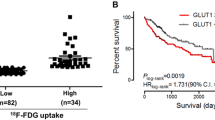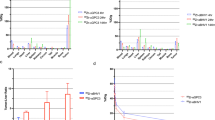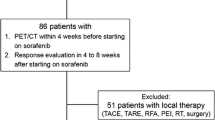Abstract
Hepatocellular carcinoma (HCC) is one of the most lethal cancers worldwide. Surgical resection and liver transplantation are still the best options for treatment. Nevertheless, as the number of patients who may benefit from these therapies is limited, alternative therapies have been developed, including chemotherapy. However, partly due to the expression of multidrug resistance (MDR) proteins, it has been found that HCC is a highly chemoresistant tumor. The major family of MDR proteins is the ATP-binding cassette (ABC) transporter superfamily, which includes P-glycoprotein (Pgp) and MDR-associated protein 1 (MRP1). Positron emission tomography using the radiolabeled analog of glucose, 2-deoxy-2-(18F)fluoro-d-glucose ([18F]FDG), has been used in diagnostic imaging of various types of tumors. Clinical studies are inconsistent but experimental studies have shown that [18F]FDG uptake is associated with tumor grade and is inversely proportional to Pgp expression in HCC. These studies unveil that [18F]FDG can be a substrate of Pgp, although that relationship remains unclear. This review sums up the relationship between MDR expression in HCC, and [18F]FDG uptake by tumor cells, showing that this radiopharmaceutical may provide a useful tool for the study of chemoresistance in HCC, and that the use of this marker may contribute to the therapeutic choice on this highly aggressive tumor.
Similar content being viewed by others
References
Jemal A, Bray F, Center MM, Ferlay J, Ward E, Forman D. Global cancer statistics. CA Cancer J Clin. 2011;61(2):69–90. doi:10.3322/caac.20107.
Skelton M, O’Neil B. Targeted therapies for hepatocellular carcinoma. Clin Adv Hematol Oncol. 2008;6(3):209–18.
Brito AF, Abrantes AM, Pinto-Costa C, Gomes AR, Mamede AC, Casalta-Lopes J, et al. Hepatocellular carcinoma and chemotherapy: the role of p53. Chemotherapy. 2012;58(5):381–6. doi:10.1159/000343656.
Ferlay J, Parkin D, Steliarova-Foucher E. Estimates of cancer incidence and mortality in Europe in 2008. Eur J Cancer. 2010;46(4):765–81. doi:10.1016/j.ejca.2009.12.014.
GLOBOCAN: Estimated Cancer Incidence, Mortality and Prevalence Worldwide in 2012. http://globocan.iarc.fr/Pages/fact_sheets_cancer.aspx. Accessed 3 Oct 2013.
Yang JD, Roberts LR. Hepatocellular carcinoma: a global view. Nat Rev Gastroenterol Hepatol. 2010;7(8):448–58. doi:10.1038/nrgastro.2010.100.
El-Serag HB, Rudolph KL. Hepatocellular carcinoma: epidemiology and molecular carcinogenesis. Gastroenterology. 2007;132(7):2557–76.
Okuda K. Hepatocellular carcinoma. J Hepatol. 2000;32(1 Suppl):225–37.
Alves RC, Alves D, Guz B, Matos C, Viana M, Harriz M, et al. Advanced hepatocellular carcinoma: review of targeted molecular drugs. Ann Hepatol. 2011;10(1):21–7.
Ni YH, Chang MH, Huang LM, Chen HL, Hsu HY, Chiu TY, et al. Hepatitis B virus infection in children and adolescents in a hyperendemic area: 15 years after mass hepatitis B vaccination. Ann Intern Med. 2001;135(9):796–800.
Harpaz R, McMahon BJ, Margolis HS, Shapiro CN, Havron D, Carpenter G, et al. Elimination of new chronic hepatitis B virus infections: results of the Alaska Immunization Program. J Infect Dis. 2000;181(2):413–8.
Wang XW, Hussain SP, Huo TI, Wu CG, Forgues M, Hofseth LJ, et al. Molecular pathogenesis of human hepatocellular carcinoma. Toxicology. 2002;181–182:43–7.
Gomaa AI, Khan SA, Leen EL, Waked I, Taylor-Robinson SD. Diagnosis of hepatocellular carcinoma. World J Gastroenterol. 2009;15(11):1301–14.
El-Serag HB, Marrero JA, Rudolph L, Reddy KR. Diagnosis and treatment of hepatocellular carcinoma. Gastroenterology. 2008;134(6):1752–63. doi:10.1053/j.gastro.2008.02.090.
Kuczynski EA, Sargent DJ, Grothey A, Kerbel RS. Drug rechallenge and treatment beyond progression: implications for drug resistance. Nat Rev Clin Oncol. 2013;10(10):571–87. doi:10.1038/nrclinonc.2013.158.
Mazzanti R, Gramantieri L, Bolondi L. Hepatocellular carcinoma: epidemiology and clinical aspects. Mol Aspects Med. 2008;29(1–2):130–43.
Cabrera R, Nelson DR. Review article: the management of hepatocellular carcinoma. Aliment Pharmacol Ther. 2010;31(4):461–76. doi:10.1111/j.1365-2036.2009.04200.x.
Casalta-Lopes J, Abrantes AM, Laranjo M, Rio J, Gonçalves AC, Oliveiros B, et al. Efflux pumps modulation in colorectal adenocarcinoma cell lines: the role of nuclear medicine. J Cancer Ther. 2011;02(03):408–17. doi:10.4236/jct.2011.23056.
Gottesman MM, Fojo T, Bates SE. Multidrug resistance in cancer: role of ATP-dependent transporters. Nat Rev Cancer. 2002;2(1):48–58.
Gillet JP, Gottesman MM. Mechanisms of multidrug resistance in cancer. Methods Mol Biol. 2010;596:47–76. doi:10.1007/978-1-60761-416-6_4.
Izquierdo MA, Scheffer GL, Schroeijers AB, de Jong MC, Scheper RJ. Vault-related resistance to anticancer drugs determined by the expression of the major vault protein LRP. Cytotechnology. 1998;27(1–3):137–48. doi:10.1023/A:1008004502861.
Saraswathy M, Gong S. Different strategies to overcome multidrug resistance in cancer. Biotechnol Adv. 2013;31(8):1397-407. doi:10.1016/j.biotechadv.2013.06.004.
Shen DW, Lu YG, Chin KV, Pastan I, Gottesman MM. Human hepatocellular carcinoma cell lines exhibit multidrug resistance unrelated to MRD1 gene expression. J Cell Sci. 1991;98(Pt 3):317–22.
Krishnakumar S, Mallikarjuna K, Desai N, Muthialu A, Venkatesan N, Sundaram A, et al. Multidrug resistant proteins: P-glycoprotein and lung resistance protein expression in retinoblastoma. Br J Ophthalmol. 2004;88(12):1521–6.
Vander Borght S, Komuta M, Libbrecht L, Katoonizadeh A, Aerts R, Dymarkowski S, et al. Expression of multidrug resistance-associated protein 1 in hepatocellular carcinoma is associated with a more aggressive tumour phenotype and may reflect a progenitor cell origin. Liver Int. 2008;28(10):1370–80. doi:10.1111/j.1478-3231.2008.01889.x.
Chen ZS, Tiwari AK. Multidrug resistance proteins (MRPs/ABCCs) in cancer chemotherapy and genetic diseases. FEBS J. 2011;278(18):3226–45. doi:10.1111/j.1742-4658.2011.08235.x.
Leslie EM, Deeley RG, Cole SP. Multidrug resistance proteins: role of P-glycoprotein, MRP1, MRP2, and BCRP (ABCG2) in tissue defense. Toxicol Appl Pharmacol. 2005;204(3):216–37.
Sharom F. Complex interplay between the P-glycoprotein multidrug efflux pump and the membrane: its role in modulating protein function. Front Oncol. 2013;4(41):1–19. doi:10.3389/fonc.2014.00041.
Ambudkar SV, Kimchi-Sarfaty C, Sauna ZE, Gottesman MM. P-glycoprotein: from genomics to mechanism. Oncogene. 2003;22(47):7468–85.
Teodori E, Dei S, Scapecchi S, Gualtieri F. The medicinal chemistry of multidrug resistance (MDR) reversing drugs. Farmaco. 2002;57(5):385–415.
Stavrovskaya AA. Cellular mechanisms of multidrug resistance of tumor cells. Biochemistry (Mosc). 2000;65(1):95–106.
Borst P, Elferink RO. Mammalian ABC transporters in health and disease. Annu Rev Biochem. 2002;71:537–92.
Kruh GD, Belinsky MG. The MRP family of drug efflux pumps. Oncogene. 2003;22(47):7537–52.
Borst P, Evers R, Kool M, Wijnholds J. The multidrug resistance protein family. Biochim Biophys Acta. 1999;1461(2):347–57.
Hipfner DR, Deeley RG, Cole SP. Structural, mechanistic and clinical aspects of MRP1. Biochim Biophys Acta. 1999;1461(2):359–76.
Juliano RL, Ling V. A surface glycoprotein modulating drug permeability in Chinese hamster ovary cell mutants. Biochim Biophys Acta. 1976;455(1):152–62.
Hennessy M, Spiers JP. A primer on the mechanics of P-glycoprotein the multidrug transporter. Pharmacol Res. 2007;55(1):1–15.
Gottesman MM, Pastan I, Ambudkar SV. P-glycoprotein and multidrug resistance. Curr Opin Genet Dev. 1996;6(5):610–7.
Lehne G. P-glycoprotein as a drug target in the treatment of multidrug resistant cancer. Curr Drug Targets. 2000;1(1):85–99.
Chen YB, Yan ML, Gong JP, Xia RP, Liu LX, Li N, et al. Establishment of hepatocellular carcinoma multidrug resistant monoclone cell line HepG2/mdr1. Chin Med J (Engl). 2007;120(8):703–7.
Ng IO, Liu CL, Fan ST, Ng M. Expression of P-glycoprotein in hepatocellular carcinoma. A determinant of chemotherapy response. Am J Clin Pathol. 2000;113(3):355–63.
Isshiki K, Nakao A, Ito M, Hamaguchi M, Takagi H. P-glycoprotein expression in hepatocellular carcinoma. J Surg Oncol. 1993;52(1):21–5.
Soini Y, Virkajärvi N, Raunio H, Pääkkö P. Expression of P-glycoprotein in hepatocellular carcinoma: a potential marker of prognosis. J Clin Pathol. 1996;49(6):470–3.
Chou YY, Cheng AL, Hsu HC. Expression of P-glycoprotein and p53 in advanced hepatocellular carcinoma treated by single agent chemotherapy: clinical correlation. J Gastroenterol Hepatol. 1997;12(8):569–75.
Grudé P, Conti F, Mennecier D, Louvel A, Houssin D, Weill B, et al. MDR1 gene expression in hepatocellular carcinoma and the peritumoral liver of patients with and without cirrhosis. Cancer Lett. 2002;186(1):107–13.
Bonin S, Pascolo L, Crocé LS, Stanta G, Tiribelli C. Gene expression of ABC proteins in hepatocellular carcinoma, perineoplastic tissue, and liver diseases. Mol Med. 2002;8(6):318–25.
Sun Z, Zhao Z, Li G, Dong S, Huang Z, Ye L, et al. Relevance of two genes in the multidrug resistance of hepatocellular carcinoma: in vivo and clinical studies. Tumori. 2010;96(1):90–6.
Huang J, Duan Q, Fan P, Ji C, Lv Y, Lin X, et al. Clinical evaluation of targeted arterial infusion of verapamil in the interventional chemotherapy of primary hepatocellular carcinoma. Cell Biochem Biophys. 2011;59(2):127–32. doi:10.1007/s12013-010-9125-9.
Tada K, Iwai M, Ishii Y, Kitagawa Y, Kashiwadani M, Nakashima T, et al. P-glycoprotein expression in hepatocellular carcinoma-from the view of histological differentiation and chemotherapy. Int Hepatol Commun. 1995;3:158.
Wang H, Chen XP, Qiu FZ. Correlation of expression of multidrug resistance protein and messenger RNA with 99mTc-methoxyisobutyl isonitrile (MIBI) imaging in patients with hepatocellular carcinoma. World J Gastroenterol. 2004;10(9):1281–5.
Palmeira A, Sousa E, Vasconcelos MH, Pinto MM. Three decades of P-gp inhibitors: skimming through several generations and scaffolds. Curr Med Chem. 2012;19(13):1946–2025.
Szakács G, Homolya L, Sarkadi B, Váradi A. MDR-ABC transporters. Encyclopedia of Molecular Pharmacology;2008: p. 748–52.
Zahreddine H, Borden KL. Mechanisms and insights into drug resistance in cancer. Front Pharmacol. 2013;4:28. doi:10.3389/fphar.2013.00028.
Ros JE, Libbrecht L, Geuken M, Jansen PL, Roskams TA. High expression of MDR1, MRP1, and MRP3 in the hepatic progenitor cell compartment and hepatocytes in severe human liver disease. J Pathol. 2003;200(5):553–60.
Wang BL, Chen XP, Zhai SP, Chen DF. Clinical significance of mrp gene in primary hepatocellular carcinoma. Hepatobiliary Pancreat Dis Int. 2003;2(3):397–403.
Warburg O. On the origin of cancer cells. Science. 1956;123:309–14.
Gasparre G, Porcelli AM, Lenaz G, Romeo G. Relevance of mitochondrial genetics and metabolism in cancer development. Cold Spring Harb Perspect Biol. 2013;5(2). doi:10.1101/cshperspect.a011411.
Moreno-Sánchez R, Rodríguez-Enríquez S, Marín-Hernández A, Saavedra E. Energy metabolism in tumor cells. FEBS J. 2007;274:1393–418.
Icard P, Lincet H. A global view of the biochemical pathways involved in the regulation of the metabolism of cancer cells. Biochim Biophys Acta. 2012;1826(2):423–33. doi:10.1016/j.bbcan.2012.07.001.
Vander Heiden MG, Cantley LC, Thompson CB. Understanding the Warburg effect: the metabolic requirements of cell proliferation. Science. 2009;324(5930):1029–33. doi:10.1126/science.1160809.
Soga T. Cancer metabolism: key players in metabolic reprogramming. Cancer Sci. 2013;104(3):275–81. doi:10.1111/cas.12085.
Wu W, Zhao S. Metabolic changes in cancer: beyond the Warburg effect. Acta Biochim Biophys Sin (Shanghai). 2013;45(1):18–26. doi:10.1093/abbs/gms104.
Hsu PP, Sabatini DM. Cancer cell metabolism: Warburg and beyond. Cell. 2008;134(5):703–7. doi:10.1016/j.cell.2008.08.021.
Gatenby RA, Gillies RJ. Why do cancers have high aerobic glycolysis? Nat Rev Cancer. 2004;4(11):891–9.
Lopci E, Fanti S. Molecular imaging in oncology. Recent Results Cancer Res. 2013;187:371–400. doi:10.1007/978-3-642-10853-2_13.
Plathow C, Weber WA. Tumor cell metabolism imaging. J Nucl Med. 2008;49(Suppl 2):43S–63S. doi:10.2967/jnumed.107.045930.
Jadvar H, Alavi A, Gambhir SS. 18F-FDG uptake in lung, breast, and colon cancers: molecular biology correlates and disease characterization. J Nucl Med. 2009;50(11):1820–7. doi:10.2967/jnumed.108.054098.
De Gaetano AM, Rufini V, Castaldi P, Gatto AM, Filograna L, Giordano A, et al. Clinical applications of (18)F-FDG PET in the management of hepatobiliary and pancreatic tumors. Abdom Imaging. 2012;37(6):983–1003. doi:10.1007/s00261-012-9845-y.
Raddatz D, Ramadori G. Carbohydrate metabolism and the liver: actual aspects from physiology and disease. Z Gastroenterol. 2007;45(1):51–62.
Amann T, Maegdefrau U, Hartmann A, Stoeltzing O, Weiss TS, Warnecke C, et al. GLUT1 and GLUT3 expression are increased in hepatocellular carcinoma and promote tumorigenesis. Z Gastroenterol. 2009;47:p3_01. doi:10.1055/s-0029-1191858.
Amann T, Hellerbrand C. GLUT1 as therapeutic target in hepatocellular carcinoma. Expert Opin Ther Targets. 2009;13(12):1411–27. doi:10.1517/14728220903307509.
Salem N, MacLennan GT, Kuang Y, Anderson PW, Schomisch SJ, Tochkov IA, et al. Quantitative evaluation of 2-deoxy-2[F-18]fluoro-d-glucose-positron emission tomography imaging on the woodchuck model of hepatocellular carcinoma with histological correlation. Mol Imaging Biol. 2007;9(3):135–43.
Sacks A, Peller PJ, Surasi DS, Chatburn L, Mercier G, Subramaniam RM. Value of PET/CT in the management of primary hepatobiliary tumors, part 2. AJR Am J Roentgenol. 2011;197(2):W260–5. doi:10.2214/AJR.11.6995.
Khan MA, Combs CS, Brunt EM, Lowe VJ, Wolverson MK, Solomon H, et al. Positron emission tomography scanning in the evaluation of hepatocellular carcinoma. J Hepatol. 2000;32(5):792–7.
Lee JE, Jang JY, Jeong SW, Lee SH, Kim SG, Cha SW, et al. Diagnostic value for extrahepatic metastases of hepatocellular carcinoma in positron emission tomography/computed tomography scan. World J Gastroenterol. 2012;18(23):2979–87. doi:10.3748/wjg.v18.i23.2979.
Wolfort RM, Papillion PW, Turnage RH, Lillien DL, Ramaswamy MR, Zibari GB. Role of FDG-PET in the evaluation and staging of hepatocellular carcinoma with comparison of tumor size, AFP level, and histologic grade. Int Surg. 2010;95(1):67–75.
Dizdarevic S, Peters AM. Imaging of multidrug resistance in cancer. Cancer Imaging. 2011;11:1–8. doi:10.1102/1470-7330.2011.0001.
Higashi K, Ueda Y, Ikeda R, Kodama Y, Guo J, Matsunari I, et al. P-glycoprotein expression is associated with FDG uptake and cell differentiation in patients with untreated lung cancer. Nucl Med Commun. 2004;25(1):19–27.
Seo S, Hatano E, Higashi T, Nakajima A, Nakamoto Y, Tada M, et al. Fluorine-18 fluorodeoxyglucose positron emission tomography predicts lymph node metastasis, P-glycoprotein expression, and recurrence after resection in mass-forming intrahepatic cholangiocarcinoma. Surgery. 2008;143(6):769–77. doi:10.1016/j.surg.2008.01.010.
Seo S, Hatano E, Higashi T, Hara T, Tada M, Tamaki N, et al. Fluorine-18 fluorodeoxyglucose positron emission tomography predicts tumor differentiation, P-glycoprotein expression, and outcome after resection in hepatocellular carcinoma. Clin Cancer Res. 2007;13(2 Pt 1):427–33.
Lorke DE, Krüger M, Buchert R, Bohuslavizki KH, Clausen M, Schumacher U. In vitro and in vivo tracer characteristics of an established multidrug-resistant human colon cancer cell line. J Nucl Med. 2001;42(4):646–54.
Bentley J, Quinn DM, Pitman RS, Warr JR, Kellett GL. The human KB multidrug-resistant cell line KB-Cl is hypersensitive to inhibitors of glycosylation. Cancer Lett. 1997;115(2):221–7.
Yamada K, Brink I, Engelhardt R. Factors influencing [F-18] 2-fluoro-2-deoxy-d-glucose (F-18 FDG) accumulation in melanoma cells: is FDG a substrate of multidrug resistance (MDR)? J Dermatol. 2005;32(5):335–45.
Seo S, Hatano E, Higashi T, Nakajima A, Nakamoto Y, Tada M, et al. P-glycoprotein expression affects 18 F-fluorodeoxyglucose accumulation in hepatocellular carcinoma in vivo and in vitro. Int J Oncol. 2009;34(5):1303–12.
Krasznai ZT, Tóth A, Mikecz P, Fodor Z, Szabó G, Galuska L, et al. Pgp inhibition by UIC2 antibody can be followed in vitro by using tumor-diagnostic radiotracers, 99mTc-MIBI and 18FDG. Eur J Pharm Sci. 2010;41(5):665–9. doi:10.1016/j.ejps.2010.09.009.
Kannan P, John C, Zoghbi SS, Halldin C, Gottesman MM, Innis RB, et al. Imaging the function of P-glycoprotein with radiotracers: pharmacokinetics and in vivo applications. Clin Pharmacol Ther. 2009;86(4):368–77. doi:10.1038/clpt.2009.138.
Chang CS, Huang WT, Yang SS, Yeh HZ, Kao CH, Chen GH. Effect of P-glycoprotein and multidrug resistance associated protein gene expression on Tc-99m MIBI imaging in hepatocellular carcinoma. Nucl Med Biol. 2003;30(2):111–7.
Shen DW, Lu YG, Chin KV, Pastan I, Gottesman MM. Human hepatocellular carcinoma cell lines exhibit multidrug resistance unrelated to MRD1 gene expression. J Cell Sci. 1991;98(3):317–22.
Márián T, Szabó G, Goda K, Nagy H, Szincsák N, Juhász I, et al. In vivo and in vitro multitracer analyses of P-glycoprotein expression-related multidrug resistance. Eur J Nucl Med Mol Imaging. 2003;30(8):1147–54.
Sharom FJ. The P-glycoprotein multidrug transporter. Essays Biochem. 2011;50(1):161–78. doi:10.1042/bse0500161.
Elferink RP, Paulusma CC. Function and pathophysiological importance of ABCB4 (MDR3 P-glycoprotein). Pflugers Arch. 2007;453(5):601–10.
Kubitz R, Dröge C, Stindt J, Weissenberger K, Häussinger D. The bile salt export pump (BSEP) in health and disease. Clin Res Hepatol Gastroenterol. 2012;36(6):536–53. doi:10.1016/j.clinre.2012.06.006.
Dean M, Rzhetsky A, Allikmets R. The human ATP-binding cassette (ABC) transporter superfamily. Genome Res. 2001;11(7):1156–66.
Paterson J, Shukla S, Black C, Tachiwada T, Garfield S, Wincovitch S, et al. Human ABCB6 localizes to both the outer mitochondrial membrane and the plasma membrane. Biochemistry. 2007;46:9443–52.
Chavan H, Oruganti M, Krishnamurthy P. The ATP-binding cassette transporter ABCB6 is induced by arsenic and protects against arsenic cytotoxicity. Toxicol Sci. 2011;120(2):519–28. doi:10.1093/toxsci/kfr008.
Staud F, Pavek P. Breast cancer resistance protein (BCRP/ABCG2). Int J Biochem Cell Biol. 2005;37(4):720–5.
Mack J, Townsend D, Beljanski V, Tew K. The ABCA2 transporter: intracellular roles in trafficking and metabolism of LDL-derived cholesterol and sterol-related compounds. Curr Drug Metab. 2007;8:47–57.
Acknowledgments and Disclosures
Ana F. Brito would like to thank the Portuguese Foundation for Science and Technology for the award of a PhD scholarship (SFRH/BD/61378/2009).
Ana F. Brito, Mónica Mendes, Ana M. Abrantes, José G. Tralhão and Maria F. Botelho have no conflicts of interest that are directly relevant to the content of this article.
Author information
Authors and Affiliations
Corresponding author
Additional information
A. F. Brito and M. Mendes contributed equally to this work.
Rights and permissions
About this article
Cite this article
Brito, A.F., Mendes, M., Abrantes, A.M. et al. Positron Emission Tomography Diagnostic Imaging in Multidrug-Resistant Hepatocellular Carcinoma: Focus on 2-Deoxy-2-(18F)Fluoro-d-Glucose. Mol Diagn Ther 18, 495–504 (2014). https://doi.org/10.1007/s40291-014-0106-3
Published:
Issue Date:
DOI: https://doi.org/10.1007/s40291-014-0106-3




